YAMAHA SUPERJET 2022 Owner's Guide
Manufacturer: YAMAHA, Model Year: 2022, Model line: SUPERJET, Model: YAMAHA SUPERJET 2022Pages: 84, PDF Size: 3.76 MB
Page 31 of 84
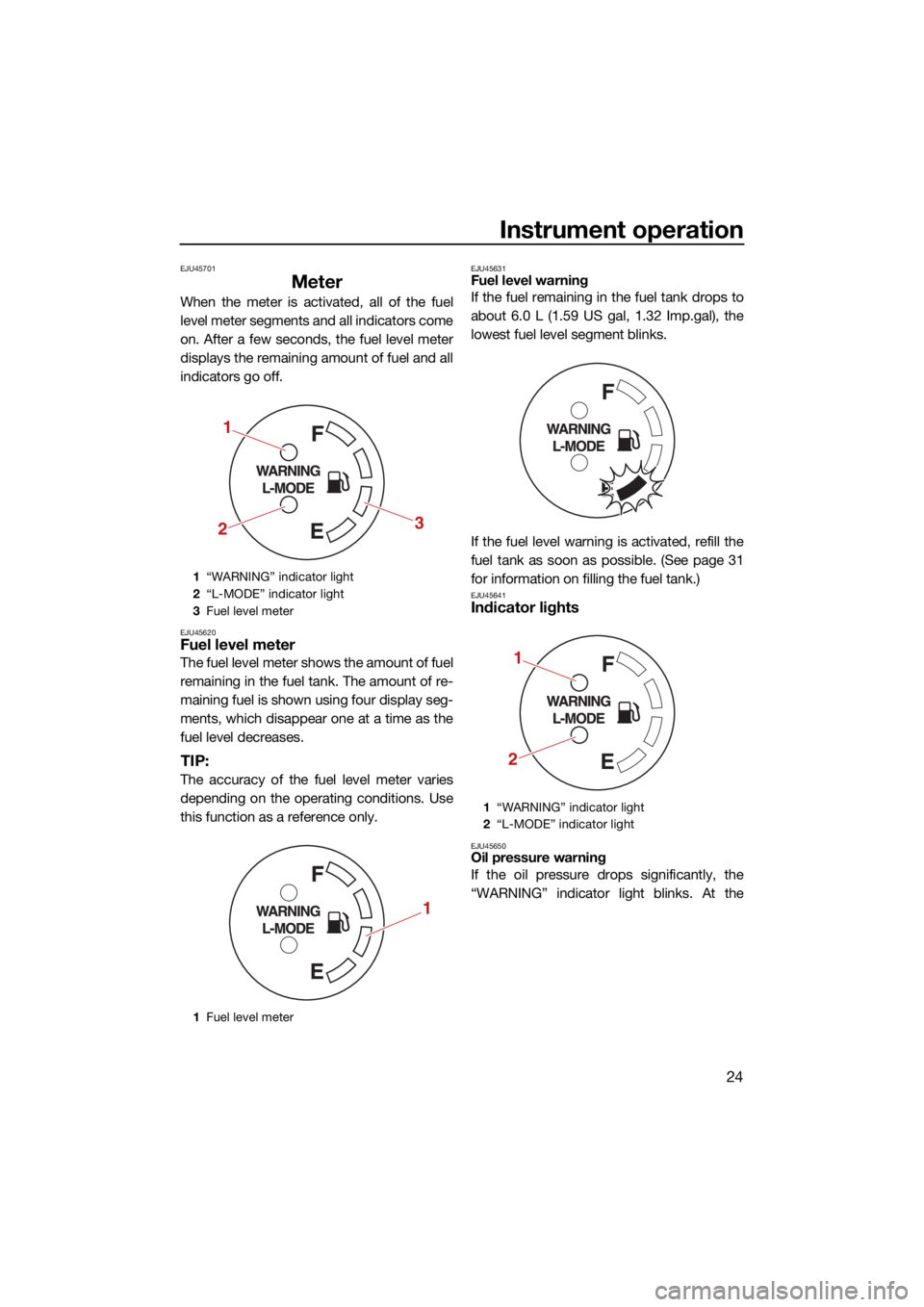
Instrument operation
24
EJU45701
Meter
When the meter is activated, all of the fuel
level meter segments and all indicators come
on. After a few seconds, the fuel level meter
displays the remaining amount of fuel and all
indicators go off.
EJU45620Fuel level meter
The fuel level meter shows the amount of fuel
remaining in the fuel tank. The amount of re-
maining fuel is shown using four display seg-
ments, which disappear one at a time as the
fuel level decreases.
TIP:
The accuracy of the fuel level meter varies
depending on the operating conditions. Use
this function as a reference only.
EJU45631Fuel level warning
If the fuel remaining in the fuel tank drops to
about 6.0 L (1.59 US gal, 1.32 Imp.gal), the
lowest fuel level segment blinks.
If the fuel level warning is activated, refill the
fuel tank as soon as possible. (See page 31
for information on filling the fuel tank.)
EJU45641Indicator lights
EJU45650Oil pressure warning
If the oil pressure drops significantly, the
“WARNING” indicator light blinks. At the
1“WARNING” indicator light
2 “L-MODE” indicator light
3 Fuel level meter
1 Fuel level meter
1
2 3
1
1
“WARNING” indicator light
2 “L-MODE” indicator light
1
2
UF4R71E0.book Page 24 Monday, May 10, 2021 1:14 PM
Page 32 of 84

Instrument operation
25
same time, the maximum engine speed is
limited.
If the oil pressure warning is activated, imme-
diately reduce the engine speed, return to
shore, and then check the engine oil level.
(See page 33 for information on checking the
engine oil level.) If the oil level is sufficient,
have a Yamaha dealer check the watercraft.
EJU45660Engine overheat warning
If the engine temperature rises significantly,
the “WARNING” indicator light comes on.
While the engine overheat warning is activat-
ed, the maximum engine speed is limited.
If the engine overheat warning is activated,
immediately reduce the engine speed, return
to shore, and then make sure that water is
being discharged from the cooling water pilot
outlet while the engine is running. If there is
no discharge of water, stop the engine, and
then check the jet intake for clogging. (See
page 72 for information on the jet intake.)NOTICE:
If you cannot locate and correct
the cause of the overheating, consult a
Yamaha dealer. Continuing to operate at higher speeds could result in severe en-
gine damage.
[ECJ00042]
EJU45681
Check engine warning
If a sensor malfunction or a short circuit is de-
tected, the “WARNING” indicator light blinks
once for several seconds.
If the check engine warning is activated, im-
mediately reduce the engine speed, return to
shore, and have a Yamaha dealer check the
engine.
EJU45690Communication disconnecting warning
If communication disconnecting is detected,
the “WARNING” indicator light and “L-
MODE” indicator light blink.
If the communication disconnecting warning
is activated, have the watercraft serviced by
a Yamaha dealer as soon as possible.
UF4R71E0.book Page 25 Monday, May 10, 2021 1:14 PM
Page 33 of 84

Equipment operation
26
EJU40336
EquipmentEJU3105AHood
The hood is removable.
Remove the hood to access the engine com-
partment.
To remove the hood:
(1) Lift the steering pole and support it withthe lock pin. (2) Turn the latch knob to the “OPEN” posi-
tion, and then pull up on the hood latch
to unlatch the hood.
(3) Grasp the hood using the handgrips pro- vided at the front and rear of the hood.
Lift the hood up and to the rear to re-
move it.
1Steering pole
1 Lock pin
1
1
1Hood latch
2 Hood latch knob
1 Handgrip
1
2
1
1
UF4R71E0.book Page 26 Monday, May 10, 2021 1:14 PM
Page 34 of 84
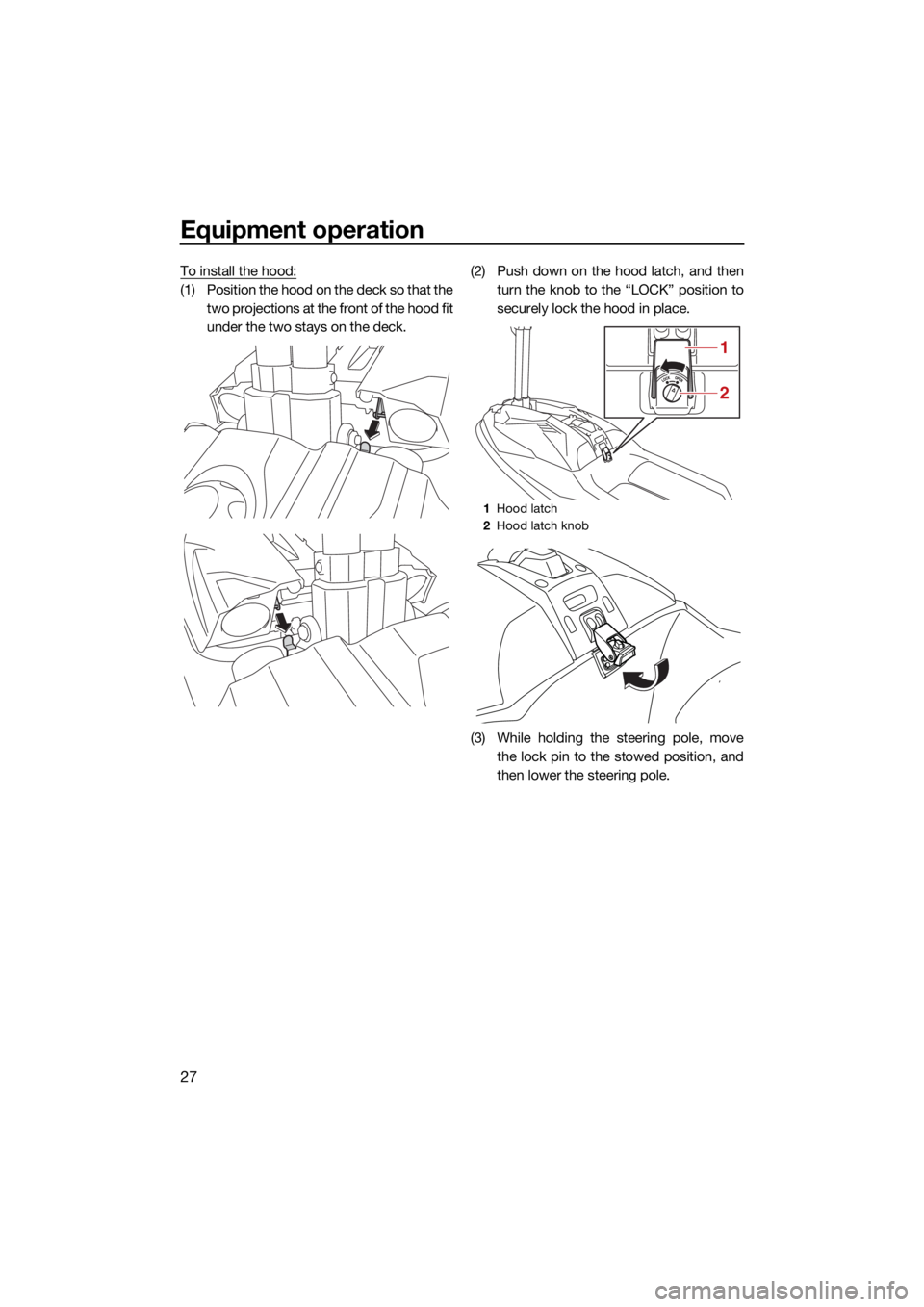
Equipment operation
27
To install the hood:
(1) Position the hood on the deck so that thetwo projections at the front of the hood fit
under the two stays on the deck. (2) Push down on the hood latch, and then
turn the knob to the “LOCK” position to
securely lock the hood in place.
(3) While holding the steering pole, move the lock pin to the stowed position, and
then lower the steering pole.
1Hood latch
2 Hood latch knob
1
2
UF4R71E0.book Page 27 Monday, May 10, 2021 1:14 PM
Page 35 of 84
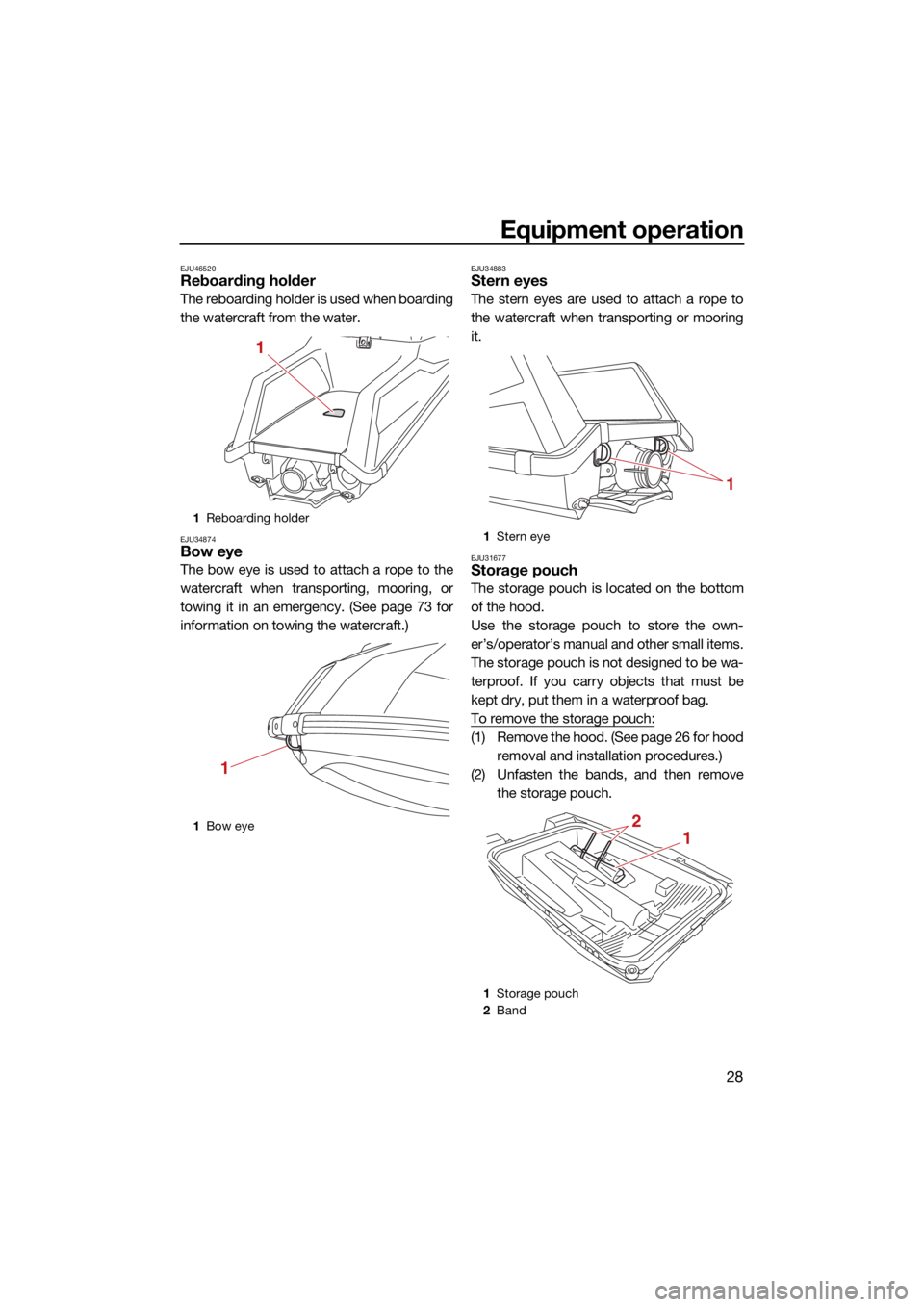
Equipment operation
28
EJU46520Reboarding holder
The reboarding holder is used when boarding
the watercraft from the water.
EJU34874Bow eye
The bow eye is used to attach a rope to the
watercraft when transporting, mooring, or
towing it in an emergency. (See page 73 for
information on towing the watercraft.)
EJU34883Stern eyes
The stern eyes are used to attach a rope to
the watercraft when transporting or mooring
it.
EJU31677Storage pouch
The storage pouch is located on the bottom
of the hood.
Use the storage pouch to store the own-
er’s/operator’s manual and other small items.
The storage pouch is not designed to be wa-
terproof. If you carry objects that must be
kept dry, put them in a waterproof bag.
To remove the storage pouch:
(1) Remove the hood. (See page 26 for hood removal and installation procedures.)
(2) Unfasten the bands, and then remove the storage pouch.
1Reboarding holder
1 Bow eye
1
1
1Stern eye
1 Storage pouch
2 Band
1
1
2
UF4R71E0.book Page 28 Monday, May 10, 2021 1:14 PM
Page 36 of 84
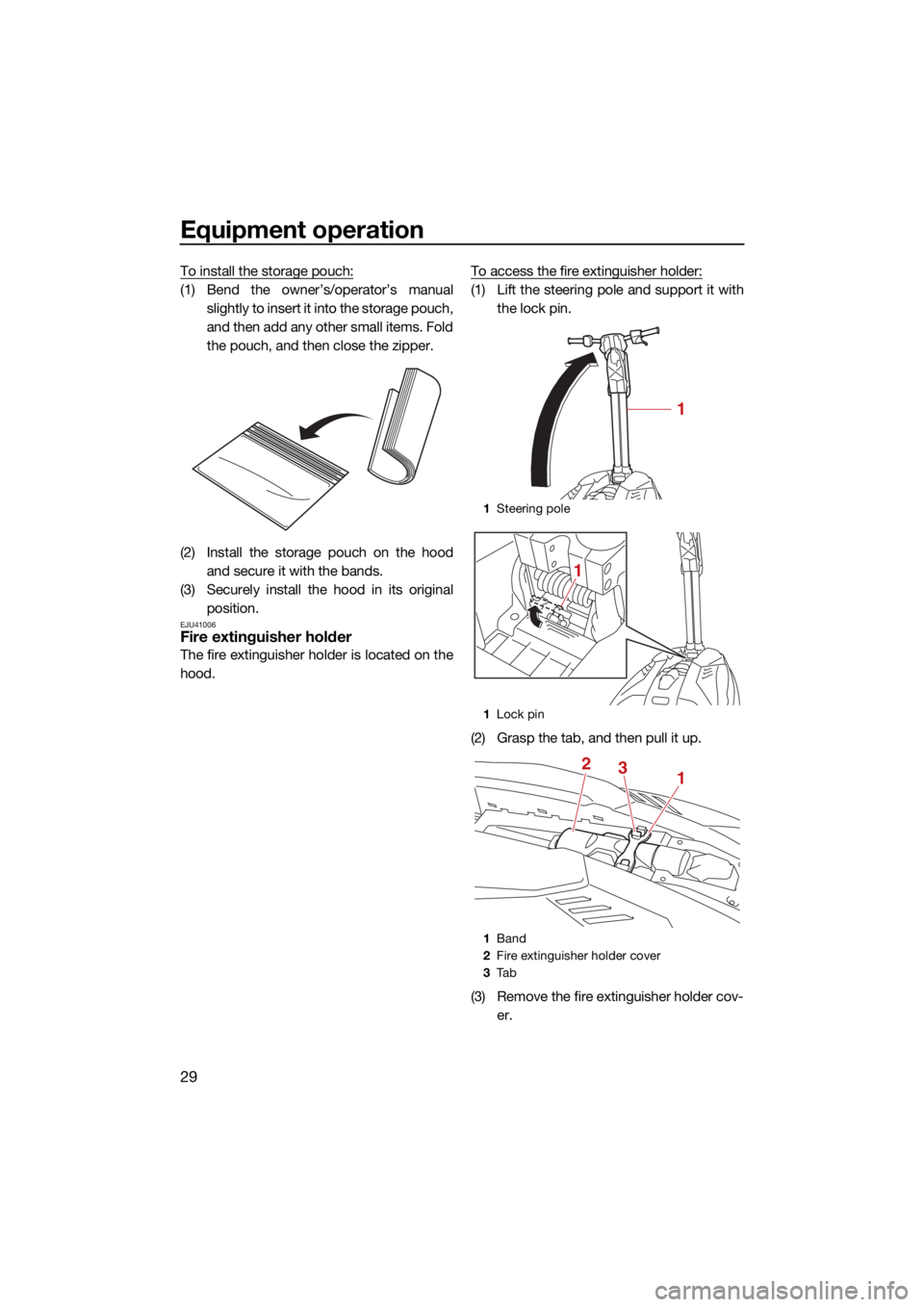
Equipment operation
29
To install the storage pouch:
(1) Bend the owner’s/operator’s manualslightly to insert it into the storage pouch,
and then add any other small items. Fold
the pouch, and then close the zipper.
(2) Install the storage pouch on the hood and secure it with the bands.
(3) Securely install the hood in its original position.
EJU41006Fire extinguisher holder
The fire extinguisher holder is located on the
hood. To access the fire extinguisher holder:
(1) Lift the steering pole and support it with
the lock pin.
(2) Grasp the tab, and then pull it up.
(3) Remove the fire extinguisher holder cov- er.
1Steering pole
1 Lock pin
1 Band
2 Fire extinguisher holder cover
3 Ta b
1
1
132
UF4R71E0.book Page 29 Monday, May 10, 2021 1:14 PM
Page 37 of 84
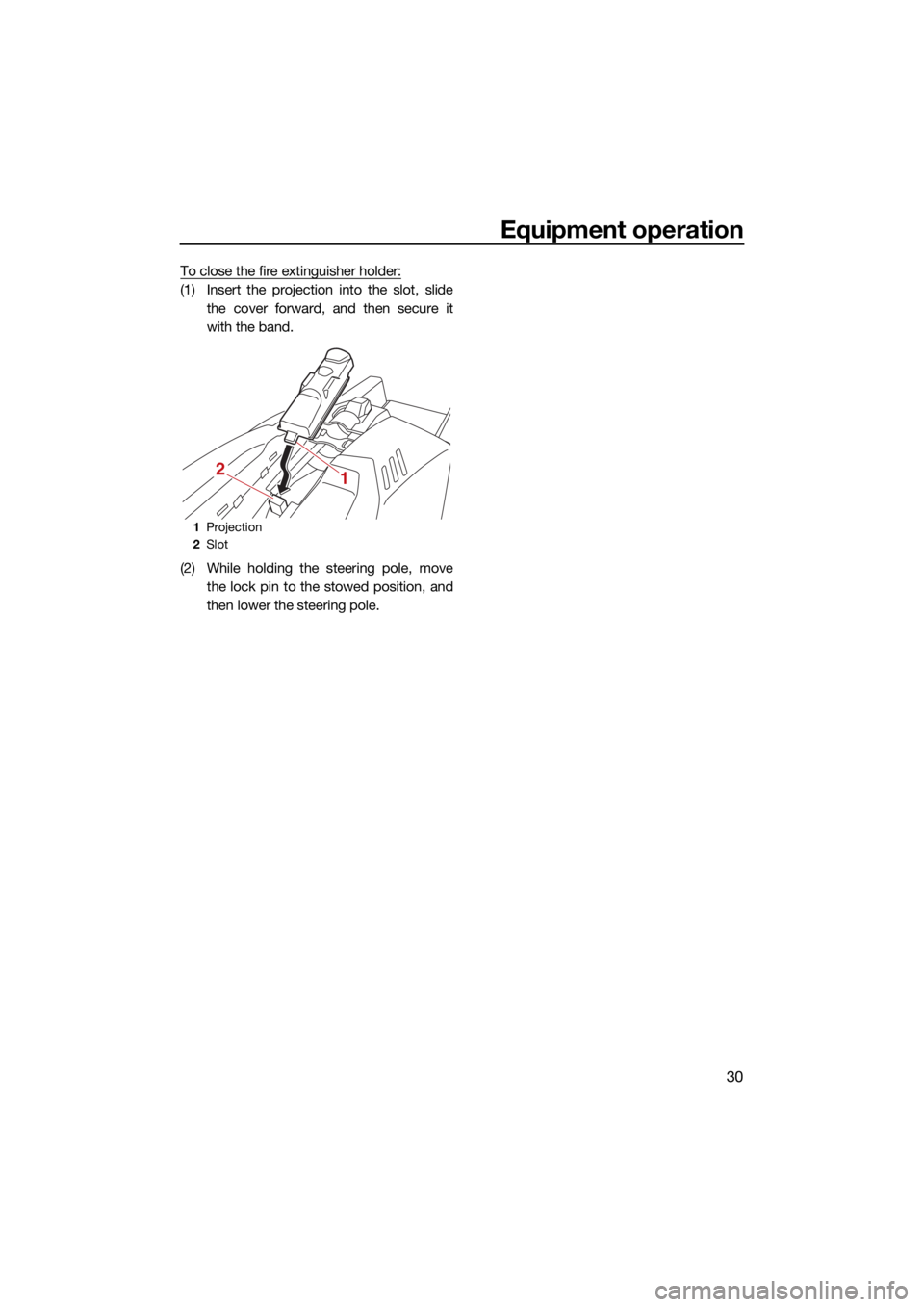
Equipment operation
30
To close the fire extinguisher holder:
(1) Insert the projection into the slot, slidethe cover forward, and then secure it
with the band.
(2) While holding the steering pole, move the lock pin to the stowed position, and
then lower the steering pole.
1Projection
2 Slot
12
UF4R71E0.book Page 30 Monday, May 10, 2021 1:14 PM
Page 38 of 84
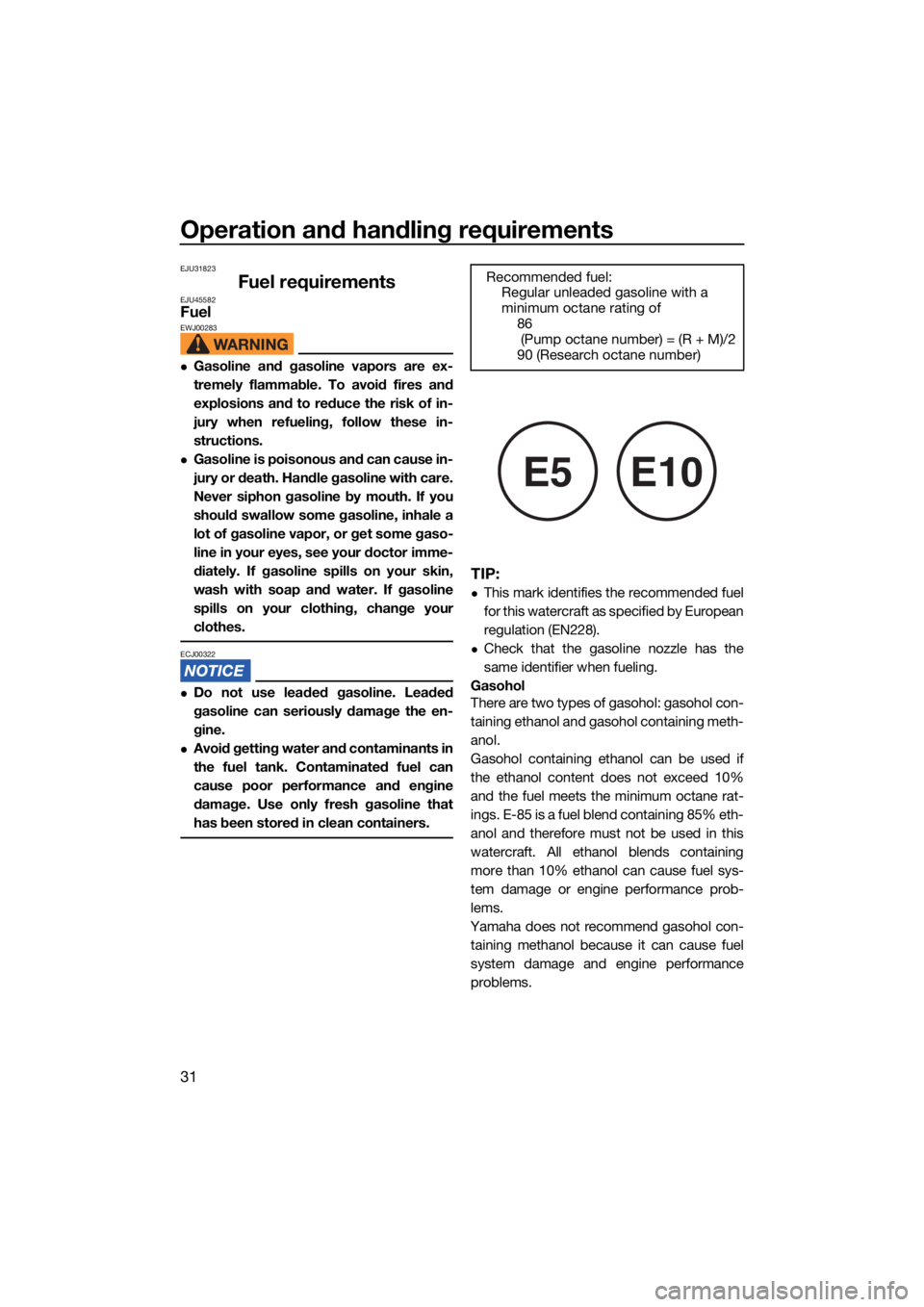
Operation and handling requirements
31
EJU31823
Fuel requirementsEJU45582FuelEWJ00283
Gasoline and gasoline vapors are ex-
tremely flammable. To avoid fires and
explosions and to reduce the risk of in-
jury when refueling, follow these in-
structions.
Gasoline is poisonous and can cause in-
jury or death. Handle gasoline with care.
Never siphon gasoline by mouth. If you
should swallow some gasoline, inhale a
lot of gasoline vapor, or get some gaso-
line in your eyes, see your doctor imme-
diately. If gasoline spills on your skin,
wash with soap and water. If gasoline
spills on your clothing, change your
clothes.
ECJ00322
Do not use leaded gasoline. Leaded
gasoline can seriously damage the en-
gine.
Avoid getting water and contaminants in
the fuel tank. Contaminated fuel can
cause poor performance and engine
damage. Use only fresh gasoline that
has been stored in clean containers.
TIP:
This mark identifies the recommended fuel
for this watercraft as specified by European
regulation (EN228).
Check that the gasoline nozzle has the
same identifier when fueling.
Gasohol
There are two types of gasohol: gasohol con-
taining ethanol and gasohol containing meth-
anol.
Gasohol containing ethanol can be used if
the ethanol content does not exceed 10%
and the fuel meets th e minimum octane rat-
ings. E-85 is a fuel blend containing 85% eth-
anol and therefore must not be used in this
watercraft. All ethanol blends containing
more than 10% ethanol can cause fuel sys-
tem damage or engine performance prob-
lems.
Yamaha does not recommend gasohol con- taining methanol because it can cause fuel
system damage and engine performance
problems. Recommended fuel:
Regular unleaded gasoline with a
minimum octane rating of 86
(Pump octane number) = (R + M)/2
90 (Research octane number)
E5E10
UF4R71E0.book Page 31 Monday, May 10, 2021 1:14 PM
Page 39 of 84
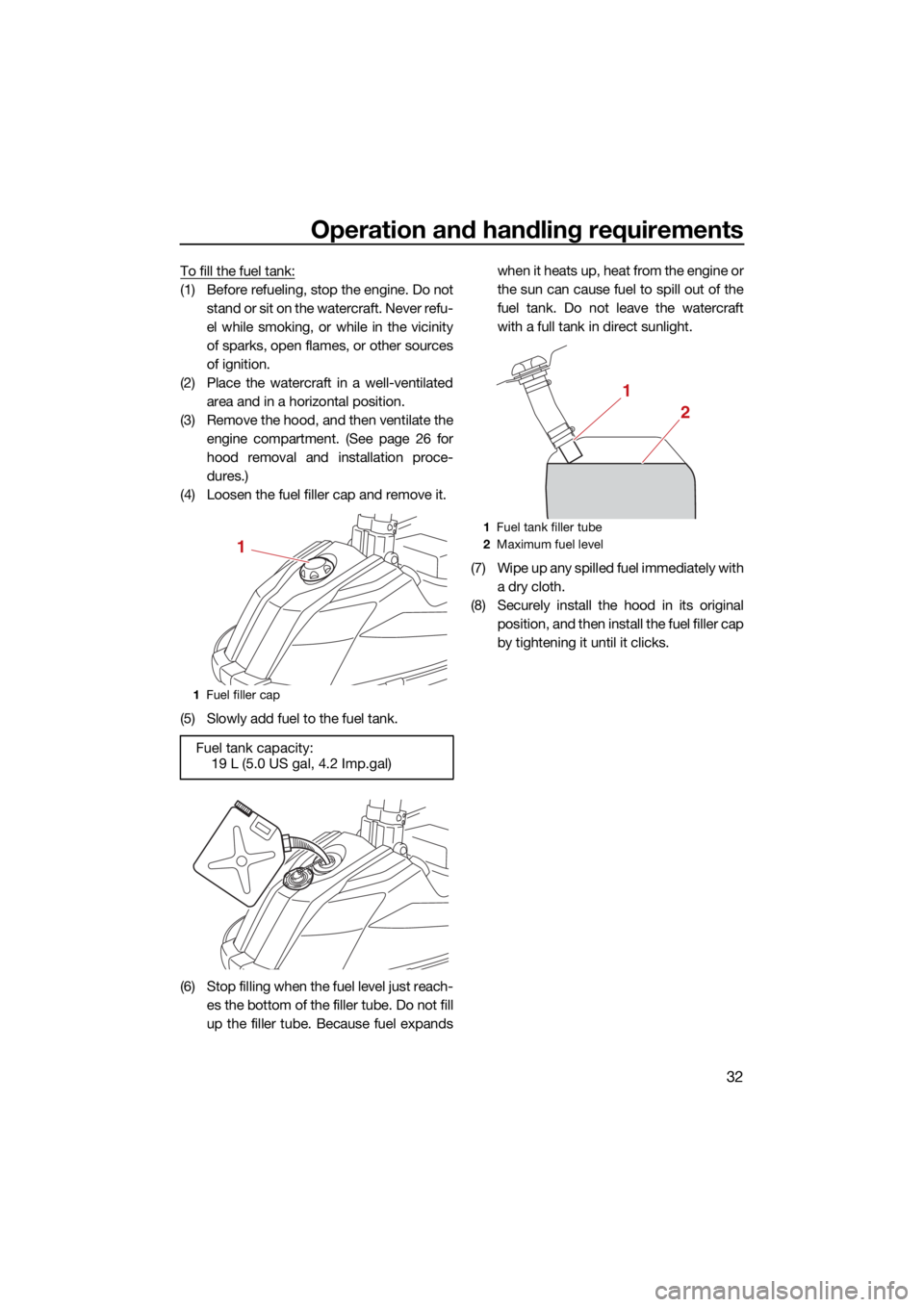
Operation and handling requirements
32
To fill the fuel tank:
(1) Before refueling, stop the engine. Do notstand or sit on the watercraft. Never refu-
el while smoking, or while in the vicinity
of sparks, open flames, or other sources
of ignition.
(2) Place the watercraft in a well-ventilated area and in a horizontal position.
(3) Remove the hood, and then ventilate the engine compartment. (See page 26 for
hood removal and installation proce-
dures.)
(4) Loosen the fuel filler cap and remove it.
(5) Slowly add fuel to the fuel tank.
(6) Stop filling when the fuel level just reach- es the bottom of the filler tube. Do not fill
up the filler tube. Because fuel expands when it heats up, heat from the engine or
the sun can cause fuel to spill out of the
fuel tank. Do not leave the watercraft
with a full tank in direct sunlight.
(7) Wipe up any spilled fuel immediately with a dry cloth.
(8) Securely install the hood in its original position, and then install the fuel filler cap
by tightening it until it clicks.
1Fuel filler cap
Fuel tank capacity:
19 L (5.0 US gal, 4.2 Imp.gal)
1
1Fuel tank filler tube
2 Maximum fuel level
2
1
UF4R71E0.book Page 32 Monday, May 10, 2021 1:14 PM
Page 40 of 84
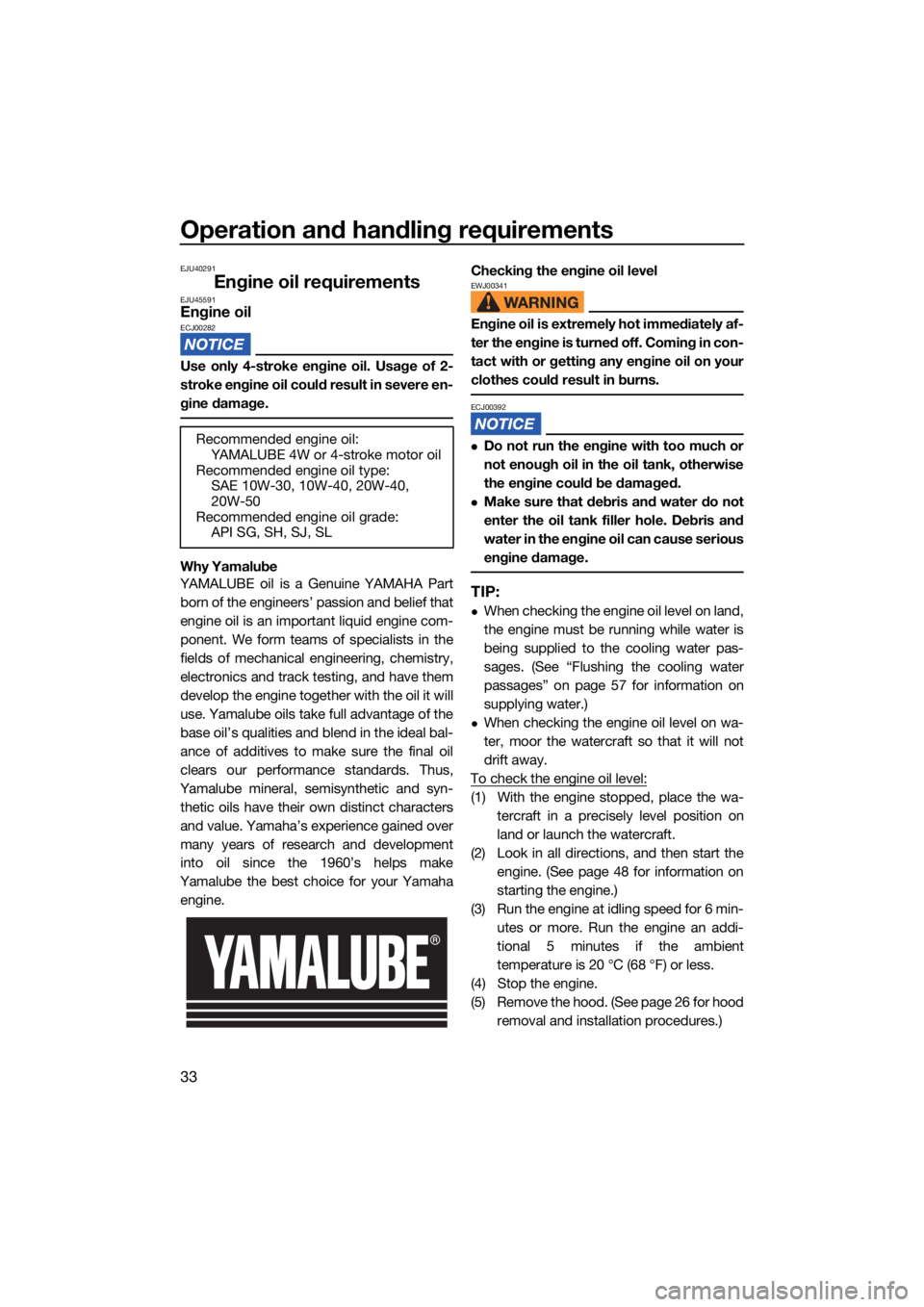
Operation and handling requirements
33
EJU40291
Engine oil requirementsEJU45591Engine oilECJ00282
Use only 4-stroke engine oil. Usage of 2-
stroke engine oil could result in severe en-
gine damage.
Why Yamalube
YAMALUBE oil is a Genuine YAMAHA Part
born of the engineers’ passion and belief that
engine oil is an important liquid engine com-
ponent. We form teams of specialists in the
fields of mechanical engineering, chemistry,
electronics and track testing, and have them
develop the engine together with the oil it will
use. Yamalube oils take full advantage of the
base oil’s qualities and blend in the ideal bal-
ance of additives to make sure the final oil
clears our performance standards. Thus,
Yamalube mineral, semisynthetic and syn- thetic oils have their own distinct characters
and value. Yamaha’s experience gained over
many years of research and development
into oil since the 1960’s helps make
Yamalube the best choice for your Yamaha engine. Checking the engine oil level
EWJ00341
Engine oil is extremely hot immediately af-
ter the engine is turned off. Coming in con-
tact with or getting any engine oil on your
clothes could result in burns.
ECJ00392
Do not run the engine with too much or
not enough oil in the oil tank, otherwise
the engine could be damaged.
Make sure that debris and water do not
enter the oil tank filler hole. Debris and
water in the engine oil can cause serious
engine damage.
TIP:
When checking the engine oil level on land,
the engine must be running while water is
being supplied to the cooling water pas-
sages. (See “Flushing the cooling water
passages” on page 57 for information on
supplying water.)
When checking the engine oil level on wa-
ter, moor the watercraft so that it will not
drift away.
To check the engine oil level:
(1) With the engine stopped, place the wa- tercraft in a precisely level position on
land or launch the watercraft.
(2) Look in all directions, and then start the engine. (See page 48 for information on
starting the engine.)
(3) Run the engine at idling speed for 6 min- utes or more. Run the engine an addi-
tional 5 minutes if the ambient
temperature is 20 °C (68 °F) or less.
(4) Stop the engine.
(5) Remove the hood. (See page 26 for hood removal and installation procedures.)
Recommended engine oil:
YAMALUBE 4W or 4-stroke motor oil
Recommended engine oil type: SAE 10W-30, 10W-40, 20W-40,
20W-50
Recommended engine oil grade: API SG, SH, SJ, SL
UF4R71E0.book Page 33 Monday, May 10, 2021 1:14 PM